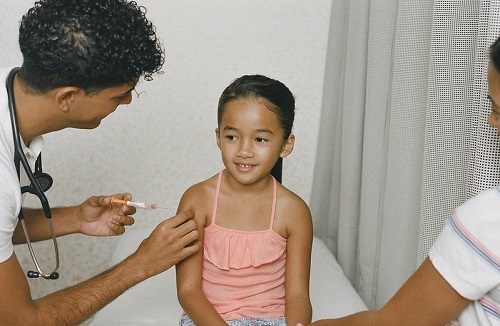To close the workgroup year, NACCHO’s Immunization Workgroup reflected on the priorities, activities, and emerging issues that occurred from August 2019 to July 2020. This year, due to the COVID-19 pandemic, many LHD immunization program’s activities and services had to be paused or altered to focus on pandemic activities. Because of this unique time, this Story from the Field highlights innovative ways some of the workgroup members have worked to maintain immunization coverage in their communities during the pandemic.
The Challenge

On March 13, the President of the United States declared the COVID-19 pandemic a national emergency, leading most states to issue stay-at-home orders and social distancing requirements. As a result, many essential public health services, including immunization, were impacted.
In May, the CDC released a Morbidity and Mortality Weekly Report detailing the effects of the COVID-19 pandemic on routine pediatric immunizations. Using Vaccines for Children (VFC) program order data and Vaccine Safety Datalink administration data, researchers conducted a comparison between January-April 2020 and January-April 2019. They found that immediately following the declaration of a national emergency, there was a stark decline in the number of VFC vaccines ordered and administered. This is likely due to stay-at-home orders, social distancing, and parents not wanting to potentially expose their child to COVID-19.
To examine the impacts of COVID-19 response on local health department (LHD) immunization programs, NACCHO conducted a survey in June. In this survey, 90% of respondents indicated their routine immunization services had been impacted by COVID-19, with 60% reporting impacts to their VFC program. In addition, 62% reported declines in their immunization rates.
LHDs have had to modify their existing immunization programs to ensure they can safely continue to administer vaccines. They have also had to increase communications in their communities, letting people know that they can and should still come in to receive vaccinations in order to stay on schedule. The following are some examples of the innovative practices members of the Immunization Workgroup have implemented.
The Solutions
In Austin, Texas, immunization clinics were closed so staff could support the COVID-19 response. Austin Public Health has since been able to reopen immunization services but has had to rethink the process to ensure the safety of staff and patients. The clinic now uses an online patient portal to verify demographics, perform a health screening, and verify immunization history prior to the patient coming to the clinic. The portal is also used to disseminate patient education materials to reduce the time spent at the clinic. If a patient does not complete the required information in the patient portal before their appointment, a staff member calls to verify the information. In addition, everyone is temperature and symptom checked as they enter the facility, everyone over two must wear a mask, and only one adult can accompany children. Clinics have also installed more hand sanitizer stations, staff sanitize areas after each patient, and no overlapping appointments are scheduled.
In Denver, the public health clinic has been able to remain open, though there has been a stark decline in immunizations since COVID-19 was declared a national emergency. Denver Public Health (DPH) has implemented a number of new practices within the clinic to ensure safety. Prior to the pandemic DPH did not schedule appointments and operated on a walk-in basis. The clinic now schedules appointments to collect all necessary information before an appointment as well as control patient flow in the waiting rooms. Staff are at each entrance to the building to take the temperature of everyone who enters, both patients and staff, and ensure visitors are wearing a mask. Additionally, only one adult is allowed to accompany children and, if possible, no additional children should be brought to the appointment. All books, magazines, toys, and educational materials have been removed from the waiting rooms.
DPH’s marketing department developed a social media campaign to ensure residents know that the clinic is still open for vaccines and are aware of the safety precautions that have been implemented. Clinics have been making reminder calls for patients under the age of 16 who are due for vaccines. Since implementing these practices, there has been a slight increase in the number of people receiving vaccines.
In California, the American Academy of Pediatrics, California; California Academy of Family Physicians; California Immunization Coalition; and California School Nurses Organization all signed a letter to Governor Gavin Newsom asking him to “publicly address the need for parents to continue to have their children vaccinated and to stay up-to-date on their vaccine schedules.” Supporting organizations asked him to communicate that parents should call their child’s doctor’s office and ask about protocols and safety measures that are in place rather than canceling or assuming the office is closed. The sign-on letter emphasized using the VFC program and stated that no child should be denied a vaccine because of economic hardship as well as offered a reminder that immunization requirements are still in place for kids going to school in the fall.
The Houston Health Department is planning how to work with schools to ensure immunization compliance requirements are not placed by the wayside as administrators are dealing with other critical issues for schools reopening. If schools decide to do virtual learning, the LHD will have to work to educate parents on the importance of still getting their children immunized before school begins. There is a concern that there may be an even greater decrease in immunization coverage rates without school enrollment being a motivator for vaccination. The Houston Health Department is also working on recruiting providers to administer a COVID-19 vaccine once available and developing an influenza outreach plan to improve vaccine uptake for adults in order to decrease burden on hospitals this flu season.
The Maryland Partnership for Prevention (MPP) is working with LHDs in Maryland to implement PrepMod, an online scheduling and registration process for appointments. This enables people to check-in and complete all necessary forms on their mobile phone and get added to a virtual queue to facilitate social distancing. MPP is holding mass vaccination clinics at schools and libraries. Using the PrepMod system eliminates the need for paper and reduces staff need for PPE.
Public Health—Seattle and King County (PHSKC) is preparing for influenza season by planning drive-through vaccine clinics, which will potentially be co-located with COVID-19 testing sites. These will be held in partnership with healthcare, school districts, cities, and community health boards. PHSKC is also planning to have a team of public health nurses administer flu and hepatitis A vaccines at homeless services sites, encampments, and correctional facilities. PHSK is participating in a group call Accountable Communities of Health which is working with BIPOC communities to develop culturally and linguistically responsive messaging on the risks of influenza and the benefits of vaccination.

The Results
Though nearly all public health clinics reported a decline in vaccine administration at the beginning of the COVID-19 pandemic, many are seeing their rates start to increase again. LHDs have been diligently working to ensure a safe environment for those who need immunizations. LHD immunization programs have also been working to promote the importance of maintaining up-to-date vaccinations or to arrange for catch-up immunizations to get individuals up to date. As a result of these and similar efforts in LHDs across the country, immunization rates are beginning to increase. However, it is vital to continue these efforts to ensure children get caught up on any missed immunizations and immunization rates are maintained throughout the pandemic among individuals of all ages.
Lessons Learned
As the world and public health continue to respond to this unprecedented pandemic, members of NACCHO’s Immunization Workgroup encourage LHD immunization programs to continue to make efforts to maintain routine immunization coverage within their jurisdictions, prepare for the upcoming influenza season to reduce the burden on the healthcare system, and prepare for the eventual distribution of the COVID-19 vaccine. Though routine immunization services and activities have been altered due to the public health emergency, it is critical that LHDs explore alternative and innovative mechanisms to provide this essential service.
Special thanks to the following NACCHO Immunization Workgroup members for their continued service to the NACCHO Immunization Workgroup, their continued efforts to promote the importance of and deliver immunizations in communities across the country, and for their contributions to this Story from the Field: Kathy Cavin, Austin Public Health/Immunization Program; Judith C. Shlay, Denver Public Health; Robert Benjamin, Sonoma County Health Department; Sean Dade, Houston Health Department; Tiffany Tate, Maryland Partnership for Prevention, Inc.; Libby Page, Public Health—Seattle and King County



